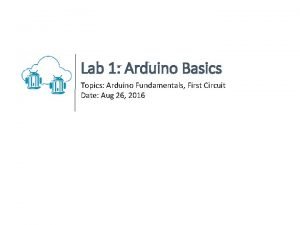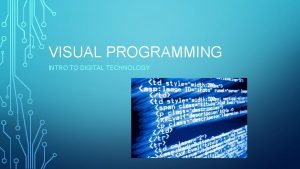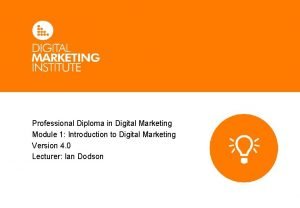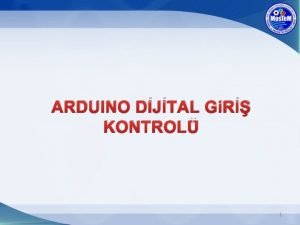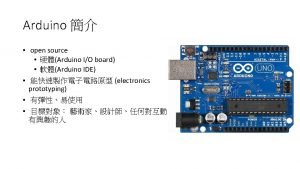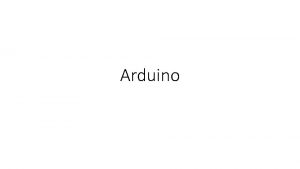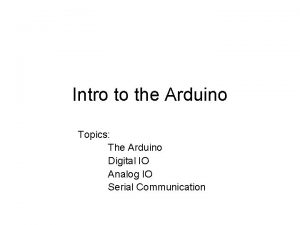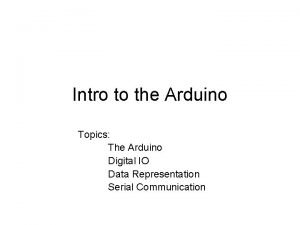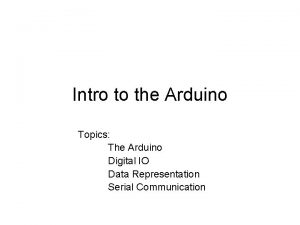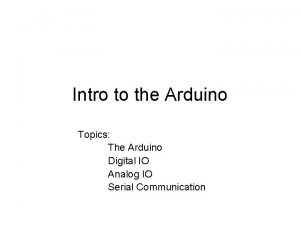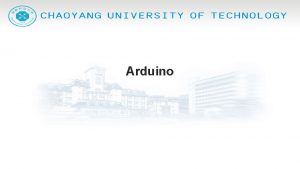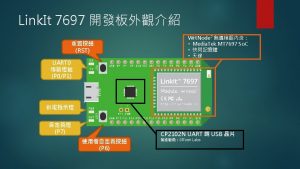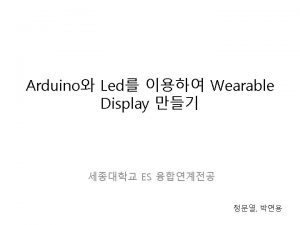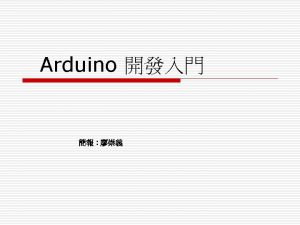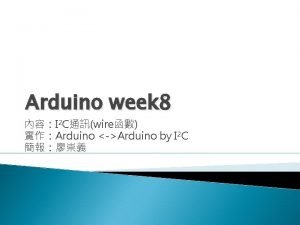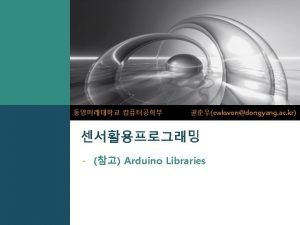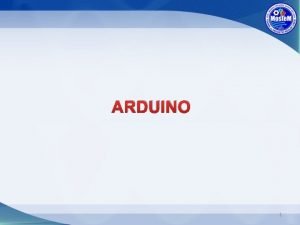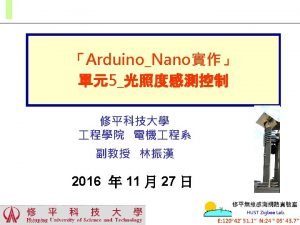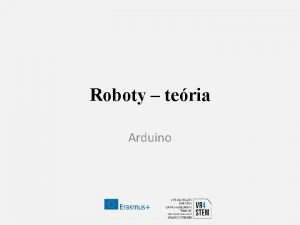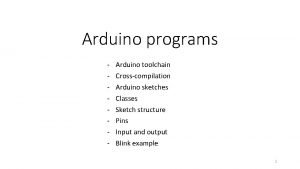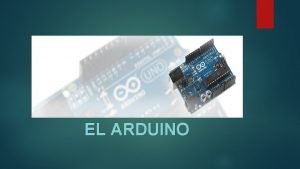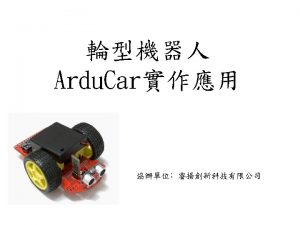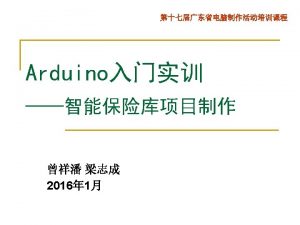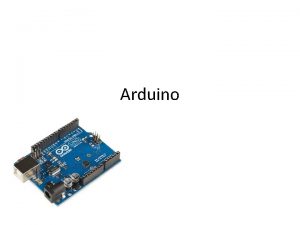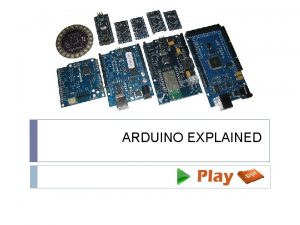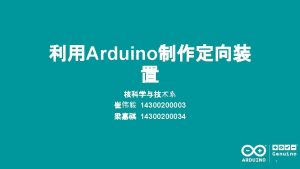Intro to the Arduino Topics The Arduino Digital























- Slides: 23

Intro to the Arduino Topics: The Arduino Digital IO Data Representation Serial Communication

Topic 1: Meet Arduino Uno

What is the Arduino todbot. com/blog/bionicarduino

Getting Started • Check out: http: //arduino. cc/en/Guide/Home. Page 1. Download & install the Arduino environment (IDE) (not needed in lab) 2. Connect the board to your computer via the USB cable 3. If needed, install the drivers (not needed in lab) 4. Launch the Arduino IDE 5. Select your board 6. Select your serial port 7. Open the blink example 8. Upload the program

Arduino IDE See: http: //arduino. cc/en/Guide/Environment for more information

Select Serial Port and Board

Status Messages todbot. com/blog/bionicarduino

todbot. com/blog/bionicarduino

Input/Output Image from Theory and Practice of Tangible User Interfaces at UC Berkley

Topic 2: Digital Input/Output • Digital IO is binary valued—it’s either on or off, 1 or 0 • Internally, all microprocessors are digital, why? 1 0

IO Pins Image from Theory and Practice of Tangible User Interfaces at UC Berkley

Arduino Digital I/0 www. mikroe. com/chapters/view/1 pin. Mode(pin, mode) Sets pin to either INPUT or OUTPUT digital. Read(pin) Reads HIGH or LOW from a pin digital. Write(pin, value) Writes HIGH or LOW to a pin Electronic stuff Output pins can provide 40 m. A of current Writing HIGH to an input pin installs a 20 KΩ pullup

Our First Program

Topic 3: Data Representation • You know how information is encoded in 0 s and 1 s (ECE 109) • Let’s look at the data types for programming the Arduino:

An Example • What output would be generated? This will be explained later This prints to the screen

Topic 4: Serial Communication Image from http: //www. ladyada. net/learn/arduino/lesson 4. html

todbot. com/blog/bionicarduino

Serial Communication • Compiling turns your program into binary data (ones and zeros) • Uploading sends the bits through USB cable to the Arduino • The two LEDs near the USB connector blink when data is transmitted • RX blinks when the Arduino is receiving data • TX blinks when the Arduino is transmitting data todbot. com/blog/bionicarduino

Open the Serial Monitor and Upload the Program

Some Commands • Serial. begin() - e. g. , Serial. begin(9600) • Serial. print() or Serial. println() - e. g. , Serial. print(value) • Serial. read() • Serial. available() • Serial. write() • Serial. parse. Int() • Example Program

Serial-to-USB chip---what does it do? The Lily. Pad and Fio Arduino require an external USB to TTY connector, such as an FTDI “cable”. In the Arduino Leonardo a single microcontroller runs the Arduino programs and handles the USB connection. Image from Theory and Practice of Tangible User Interfaces at UC Berkley

Two different communication protocols Serial (TTL): Image from http: //www. fiz-ix. com/2013/02/introduction-to-arduino-serial-communication/

USB Protocol Image from http: //en. wikipedia. org/wiki/USB • Much more complicated
 Arduino anatomy
Arduino anatomy Intro to digital technology
Intro to digital technology Digital marketing topics
Digital marketing topics Arduino digital read
Arduino digital read Apa yang dimaksud dengan warga digital?
Apa yang dimaksud dengan warga digital? E-commerce: digital markets, digital goods
E-commerce: digital markets, digital goods Digital data digital signals
Digital data digital signals Data encoding and modulation
Data encoding and modulation E-commerce: digital markets, digital goods
E-commerce: digital markets, digital goods Signal encoding techniques in data communication
Signal encoding techniques in data communication Luxembourg digital innovation hub
Luxembourg digital innovation hub Unique features of digital markets
Unique features of digital markets Hình ảnh bộ gõ cơ thể búng tay
Hình ảnh bộ gõ cơ thể búng tay Ng-html
Ng-html Bổ thể
Bổ thể Tỉ lệ cơ thể trẻ em
Tỉ lệ cơ thể trẻ em Chó sói
Chó sói Tư thế worms-breton
Tư thế worms-breton Chúa sống lại
Chúa sống lại Các môn thể thao bắt đầu bằng tiếng nhảy
Các môn thể thao bắt đầu bằng tiếng nhảy Thế nào là hệ số cao nhất
Thế nào là hệ số cao nhất Các châu lục và đại dương trên thế giới
Các châu lục và đại dương trên thế giới Công của trọng lực
Công của trọng lực Trời xanh đây là của chúng ta thể thơ
Trời xanh đây là của chúng ta thể thơ
